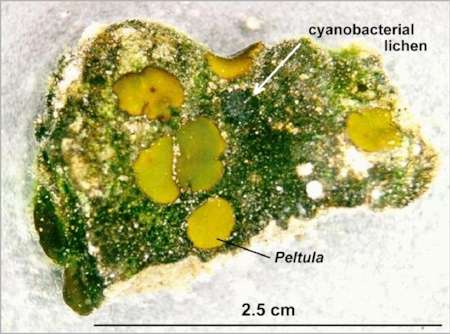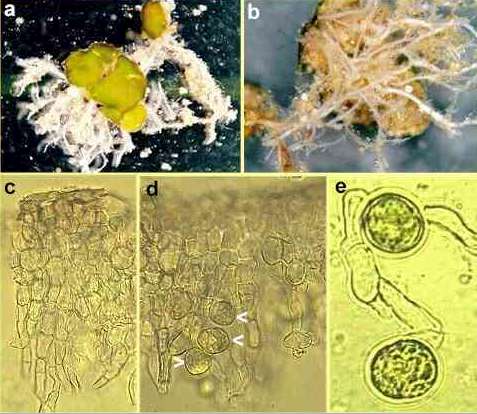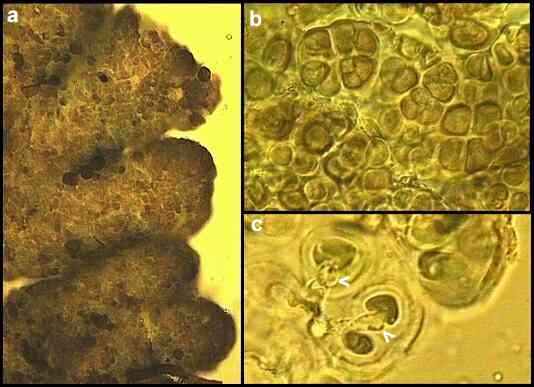..
LICHEN BIOLOGY (continued) Cryptobiotic soil crusts In many of the drier regions of the world, such as large areas of the North American deserts, the African deserts, the Australian deserts and the central desert regions of Spain, the soil surfaces are covered with an inconspicuous crust-like material which may be only a fraction of a millimeter thick. These soil crusts are extremely fragile but they serve a vital role in stabilising the soil surface, and they can eventually lead to the formation of true soils that will support increasingly larger life forms. These soil crusts are called cryptobiotic crusts or microbiotic crusts (Figs 2 -6).
Fig 1. A sign in the Arches National Park, Utah [© Jim Deacon]
Fig 2. A small part of a cryptobiotic crust in Texas. Note the grey colour of this dried soil crust, and the cluster of tiny organisms at bottom right. [© Jim Deacon]
Fig 3. A small fragment of a cryptobiotic crust from Texas, when remoistened with water, illustrating the complexity of the microbial community. Most of the soil surface is covered with a mat of the cyanobacterium, Scytonema. But two small lichens are also seen - a species of Peltula which has a green algal symbiont (6 separate thalli can be seen) and the cyanobacterial lichen, Collema sp. [© Jim Deacon].
Fig. 4. A species of Peltula from a soil crust community. Images a (upper surface) and b (lower surface) show that the lichen consists of separate lobes, termed squamules (about 2 mm diameter), connected to one another by a system of fungal cords. In a vertical section (c), the green lobes have a typical lichen structure: the upper zone (cortex) consists of densely packed fungal tissue, whereas the hyphae of the medulla have a more normal appearance and are associated with green algae (d, arrowheads). At high magnification (e) the algal cells are seen to be intimately associated with fungal hyphae, presumably for transfer of organic nutrients.
Fig. 5. The cyanobacterial lichen (Collema) has a lobed margin, seen in (a) above. There is no fungal cortex like that in Peltula. Instead, the upper surface of the lichen consists of clusters of dividing cyanobacterial cells embedded in gelatinous sheaths (b). A network of fungal hyphae extended into the sand from the base of the lichen. These hyphae branched repeatedly near the base of the lichen and the individual short branches (arrowheads in c) penetrated into the sheaths surrounding the cyanobacterial cells. Lichen ecology and significanceLichens are classic "pioneer" colonisers in a vast range of environments. They grow on the bark of temperate trees or as epiphytes on the leaves of tropical rain forest trees. Others occupy some of the most inhospitable environments on earth, growing on cooled lava flows and bare rock surfaces, where they help in the process of soil formation, and on desert sands where they help to stabilise the surface and enrich it with nutrients. Some other types of lichen grow abundantly on tundra soils, providing a vital winter food source for animals (including reindeer and caribou) in arctic and sub-arctic regions. Yet other lichens grow on or in the perennial leaves of some economically important tropical crop plants such as coffee, cacao and rubber. Lichens are amongst the slowest-growing organisms, but their tolerance of environmental extremes enables them to colonise habitats where few other macroscopic organisms can grow. They grow where neither the fungal partner nor the photosynthetic partner could survive alone, because they benefit from their unique symbiotic association. However, most lichens are highly intolerant of atmospheric pollution, particularly sulphur dioxide, so they are found mainly in rural environments rather than cities. Only a few species, such as Physcia grisea and Xanthoria parietina, are found commonly in towns, and even they grow poorly in towns compared with in non-polluted environments. Part of the reason for this intolerance is the extreme efficiency of lichen fungi in accumulating nutrients (including pollutants) from trace levels in the atmosphere. An extreme demonstration of this is the ability of lichens to accumulate radioactive isotopes from the environment. Following the Chernobyl disaster, the lichens (mainly Cladonia rangiferina, the "reindeer moss") of northern Scandinavia accumulated so much radioactivity that reindeer feeding on them were considered dangerous for human consumption. All these features make lichens interesting and significant in environmental terms. But lichens also pose challenging scientific problems - how do two or more microorganisms interact at the cellular, genetical and biochemical levels to produce a unique, hybrid organism? Sources of further information Nash TH (1996) Lichen Biology. Cambridge University Press, Cambridge. The main journal for all aspects of lichens is The Lichenologist, published by Academic Press. Useful WWW resources: http://www.lichen.com/vocabulary.html |




